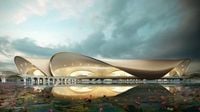On October 8, 2025, a momentous chapter began for Mumbai as Indian Prime Minister Narendra Modi officially inaugurated the Navi Mumbai International Airport (NMIA), marking the culmination of nearly two decades of anticipation, engineering, and planning. The event, attended by dignitaries, government officials, and enthusiastic crowds, was not just a ribbon-cutting but a celebration of Mumbai's emergence as a global connectivity hub and a testament to India's growing stature in aviation.
For years, Mumbai—one of the world's most densely populated cities—has struggled with a single, overburdened airport. Chhatrapati Shivaji Maharaj International Airport (BOM) handled more than 54 million passengers annually by 2025, up from 48.83 million in 2019, leading to overcrowding, long lines, and persistent delays. The opening of NMIA, with its gleaming terminals and state-of-the-art technology, promises to ease this pressure and propel Mumbai into the ranks of global multi-airport cities like London, New York, and Tokyo, as reported by Hindustan Times.
Phase one of the airport, constructed at a cost of approximately Rs. 19,650 crores ($2.37 billion), features a single runway and terminal designed to handle 20 million passengers annually. As the airport expands, it will boast four terminals and two runways, eventually accommodating up to 155 million passengers each year. The airport also aims to process 3.25 million metric tons of cargo annually, a boon for Mumbai’s thriving pharmaceutical and e-commerce industries. According to BBC, NMIA’s cargo operations debut with 800,000 tons of annual capacity and include a general aviation terminal capable of housing up to 75 business jets—the largest such facility in India.
Prime Minister Modi, addressing the crowd at the inauguration, reflected on the significance of the project: “In 2014, we only had 74 airports. Today, we have more than 160. With this new airport, Maharashtra farmers will be able to connect with the supermarkets of Europe and Middle East. And the fishermen’s produce can quickly reach the global market.” His remarks underscored the broader economic and social impact NMIA is expected to have—not just as a transportation hub, but as a catalyst for local industry and international trade.
The Prime Minister also spoke of his vision to establish India as a major Maintenance, Repair, and Overhaul (MRO) hub by the end of the decade, highlighting the opportunities the new airport would create for the country’s youth. “India is the youngest country in the world, and its strength lies in its youth,” he said, as quoted by Times of India. The airport is projected to generate more than 200,000 jobs across sectors like aviation, logistics, IT, hospitality, and real estate, according to Hindustan Times.
NMIA’s design is as ambitious as its scale. Conceived by Zaha Hadid Architects, the terminal draws inspiration from the lotus, India’s national flower, symbolizing purity and resilience. The structure features a canopy of golden petals and interiors that blend traditional jaali latticework with modern glass and lighting, creating a calm, inviting space for travelers. “Inspired by the lotus, India’s national flower, our airport’s architecture blends cultural heritage with world-class design and sustainability features,” a spokesperson for Navi Mumbai International Airport told Economic Times.
Sustainability is woven into the airport’s DNA. The facility incorporates natural cooling, renewable energy, water recycling, dedicated storage for Sustainable Aviation Fuel (SAF), and solar power generation. Electric vehicle (EV) bus services will connect passengers across the city, and, notably, NMIA is set to become the first airport in India connected by water taxi—a service running between the iconic Gateway of India monument and the airport itself. While Chief Minister Devendra Fadnavis confirmed the water taxi plan, a specific timeline has yet to be announced, as noted by BBC.
But NMIA’s innovation doesn’t stop at architecture and sustainability. It is India’s first fully digital airport, featuring pre-booking for vehicle parking, online baggage drop, and AI-enabled immigration services. Arun Bansal, CEO of Adani Airports Holdings Ltd (AAHL), described it as an “anxiety-free airport” due to its automation and digital facilities. “We are experimenting with AI-enabled baggage tracking in Ahmedabad, and here, you will be able to get a message on your phone telling you, for example, that your bag is number 20 on the carousel,” he explained to Hindustan Times.
Several major airlines have already announced plans to operate out of the new airport. Air India Express will launch 20 daily departures, including international routes, while IndiGo and Akasa Air will add dozens of daily flights, with Akasa Air starting more than 100 weekly flights. Commercial operations are expected to begin in December 2025, initially for 12 hours daily, with about 40% international traffic—eventually rising to 75% as the airport ramps up, according to Hindustan Times.
Despite its promise, NMIA faces a critical challenge: ground connectivity. While the Mumbai Trans Harbour Link—the country’s largest sea bridge—has reduced travel time from South Mumbai to 20 minutes, peak-hour congestion on connecting roads can stretch journeys to a couple of hours. Metro extensions and express bus routes are still under development, and with no direct metro link from key commercial districts at launch, most travelers will rely on cars and taxis, potentially adding to the city’s notorious traffic woes. Shuttle services will need careful coordination with train and bus timetables, a logistical puzzle in Mumbai’s complex transit network, as highlighted by aviation analyst Mark D. Martin in BBC.
Still, the vision for NMIA is to serve as a model for future Indian airports. Jeet Adani, director of airports for the Adani Group—the project’s key funder—said, “Singapore Changi is known for efficiency and passenger experience. NMI is designed to exceed it in ultimate capacity, while matching its digital backbone. Seoul Incheon and Tokyo Narita are examples of Asian order and technology. We aim to meet those benchmarks on airside, while surpassing them in growth headroom.”
For many in Mumbai, the opening of NMIA is both a relief and a test. It promises smoother journeys, new opportunities for business and leisure, and a gateway to the world. But its ultimate success will depend on whether the city can match its aviation ambitions with equally robust and efficient ground transport solutions. If connectivity catches up with the airport’s vision, Mumbai’s new gateway could finally give the city—and its travelers—the breathing room they’ve long needed.





